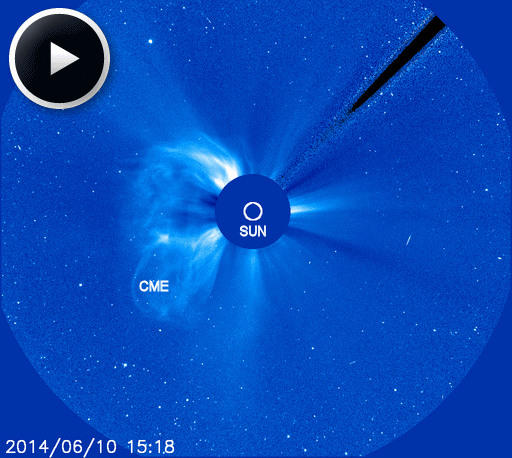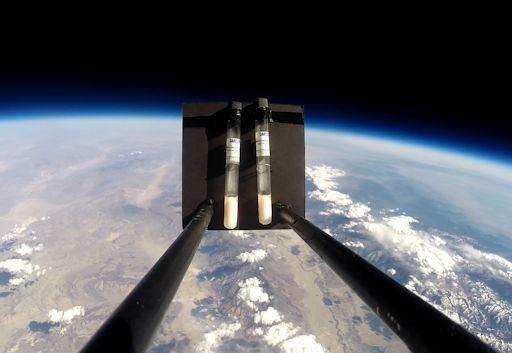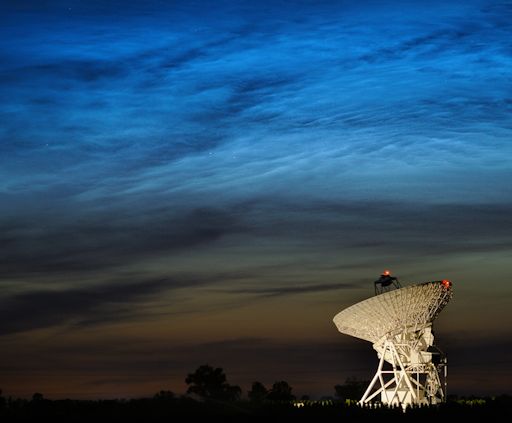Listen to radar echoes from satellites and meteors, live on listener-supported Space Weather Radio. | | |
ANOTHER X-FLARE: Solar activity remains high. Active sunspot AR2087 unleashed another X-flare on June 11th (X1.0), following two X-flares (X2.1 and X1.5) on June 10th. The latest blast was intense but short-lived, and it is not expected to have significant Earth-effects. Solar flare alerts: text, voice
INCOMING CME: Yesterday's double X-flare may have produced a geoeffective CME after all. At first it appeared that Earth was outside the line of fire, but a closer look at the CME reveals an Earth-directed component. Click to view a movie of the explosion from the Solar and Heliospheric Observatory:

The movie shows a faint CME associated with the first X-flare emerging around 1200 UT. A second, brighter CME from the second X-flare quickly overtakes it, forming a "cannibal CME." Computer models run yesterday by NOAA analysts suggest the merged storm cloud will reach Earth mid-day on June 13th. The glancing blow could spark polar geomagnetic storms.
Meanwhile, more X-flares are in the offing. At least two sunspots (AR2080 and AR2087) have unstable 'delta-class' magnetic fields that could erupt at any moment. The source of yesterday's X-flares, AR2087, is particularly potent, and it is turning toward Earth. NOAA forecasters estimate a 60% chance of M-flares and a 30% chance of X-flares on June 11th. Solar flare alerts: text, voice
Realtime Space Weather Photo Gallery
HALOBACTERIA SET A NEW HIGH-ALTITUDE RECORD: Astrobiologsts have long wondered if halobacteria, a terrestrial extremophile with a special talent for shielding itself from UV radiation, could survive on the planet Mars. To find the answer, the students of Earth to Sky Calculus have been flying halobacteria onboard balloons to the top of Earth's atmosphere. During their latest flight on June 7th, the microbes set a high-altitude record for their species. Here they are 116,524 feet above the Sierras of central California:

The previous record set by the students just last month was 112,000 feet, so this was nearly a mile higher than before.
During the June 7th flight, onboard sensors registered temperatures as low as -60 C, air pressures of 1% sea level, and cosmic radiation levels 25 times Earth-normal. Those are conditions akin to the planet Mars. Three hours after they were launched, the bacteria landed in the Death Valley National Park: snapshot. This means they experienced a 100 C swing in temperature, a 100-fold change in air pressure, and a 25-fold surge of radiation.
The students have already shown that halobacteria can survive trips like this. Now they are working to determine survival rates, growth curves, and to look at possible mutations among the halo-survivors. Results could contribute to an important body of knowledge about the prospects for life on Mars -- past, present, and future.
Realtime Space Weather Photo Gallery
SPECTACULAR NOCTILUCENT CLOUDS: On June 9th, a spectacular display of noctilucent clouds (NLCs) swept across central Europe. "I have waited three years to take a picture like this," says Piotr Majewski who witnessed the apparition at the Torun Centre for Astronomy in Poland:

"Noctilucent cloud season has officially begun here in Poland," says Marek Nikodem. "I saw the same display from the town of Szubin, and it was spectacular." Nikodem is a long-time photographer of noctilucent clouds. Last night he framed a nest of storks backlit by electric blue.
Noctilucent clouds are a summertime phenomenon. NASA's AIM spacecraft spotted the first NLCs of the 2014 season on May 24th, and they have been intensifying ever since. Long ago, NLCs were confined to the Arctic, but in recent years they have been sighted as far south as Colorado and Utah. Some researchers think the increasing visibility is a sign of climate change. Whatever the cause, sky watchers should be alert for NLCs as northern summer unfolds.
Observing tips: Look west 30 to 60 minutes after sunset when the Sun has dipped 6o to 16o below the horizon. If you see luminous blue-white tendrils spreading across the sky, you may have spotted a noctilucent cloud.
Realtime Aurora Photo Gallery
Realtime Comet Photo Gallery
Realtime Meteor Photo Gallery
Every night, a network of NASA all-sky cameras scans the skies above the United States for meteoritic fireballs. Automated software maintained by NASA's Meteoroid Environment Office calculates their orbits, velocity, penetration depth in Earth's atmosphere and many other characteristics. Daily results are presented here on Spaceweather.com.
On Jun. 11, 2014, the network reported 23 fireballs.
( 23 sporadics)

In this diagram of the inner solar system, all of the fireball orbits intersect at a single point--Earth. The orbits are color-coded by velocity, from slow (red) to fast (blue). [Larger image] [movies]
Potentially Hazardous Asteroids (
PHAs) are space rocks larger than approximately 100m that can come closer to Earth than 0.05 AU. None of the known PHAs is on a collision course with our planet, although astronomers are finding
new ones all the time.
On June 11, 2014 there were potentially hazardous asteroids.
Notes: LD means "Lunar Distance." 1 LD = 384,401 km, the distance between Earth and the Moon. 1 LD also equals 0.00256 AU. MAG is the visual magnitude of the asteroid on the date of closest approach. | | The official U.S. government space weather bureau |
| | The first place to look for information about sundogs, pillars, rainbows and related phenomena. |
| | Researchers call it a "Hubble for the sun." SDO is the most advanced solar observatory ever. |
| | 3D views of the sun from NASA's Solar and Terrestrial Relations Observatory |
| | Realtime and archival images of the Sun from SOHO. |
| | from the NOAA Space Environment Center |
| | the underlying science of space weather |

